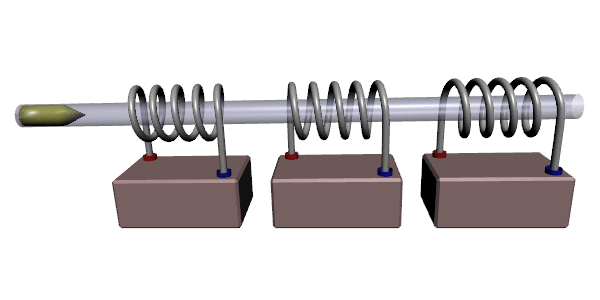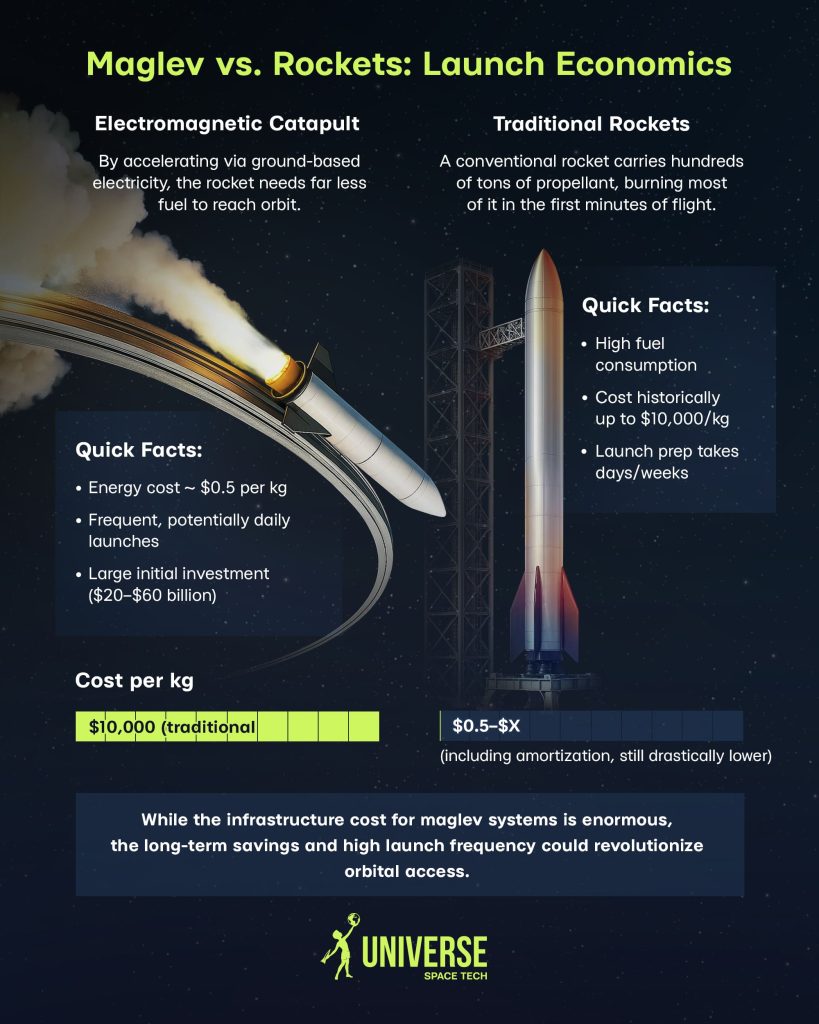Just imagine a spacecraft accelerating to breakneck speeds along a magnetic track before pulling away from the ground. This is not a fiction from a sci-fi movie, but a real technology that engineers are working on – an electromagnetic catapult to launch objects into space. Already in 2028, private Chinese company Galactic Energy plans to test the world’s first launch pad with electromagnetic rocket boosters. The idea of using magnets instead of chemical engines to overcome gravity has been known for quite some time (the so-called mass driver concept), but only now the development of magnetic suspension bearing and superconductor technologies has brought it closer to reality.
Mass driver: From fiction to engineering projects
Mass driver is the general name for systems that accelerate objects using electromagnetism. The mass driver concept was popularized back in the 1970s by physicist Gerard K. O’Neill as a way to launch cargo from the Moon into space without rockets. Imagine a long electromagnetic cannon on a lunar base “firing” containers of minerals directly into the Moon’s orbit – it’s fantastic, but physically possible due to the Moon’s low gravity and lack of atmosphere. Mass driver is actually a version of a coilgun: a number of coils in series create a magnetic field that accelerates a capsule with a ferromagnetic or superconducting core. After reaching the end of the guide, the capsule flies out into space, and the upper stage (the magnetic “sleeve”) returns back for reuse. Absolutely no fuel combustion – just electricity and magnets.

The idea of a mass driver has appeared repeatedly in science fiction works and engineering studies. Besides lunar applications, designs have been proposed for Earth as well. NASA considered the concept of the MagLifter, a relatively short magnetic track capable of accelerating a heavy launch vehicle to ~300 m/s before launch. Although MagLifter was never realized, calculations showed that even this speed increase could have reduced the mass of the first stage by 20% and significantly saved fuel.
The next design option is the StarTram project, probably one of the most detailed mass drivers for Earth. Its authors (Dr. James Powell, the inventor of the superconducting maglev, and Eng. George Mays) proposed the construction of a giant maglev track 1300-1600 km long, which gradually rises upward and reaches an altitude of ~20 km. Inside is rarefied air or vacuum to avoid aerodynamic drag. The capsule should accelerate through this tunnel on a magnetic cushion at a speed of ~8 km/s (almost orbital speed). At the end of the track, the vehicle will already have enough kinetic energy to enter orbit with only small corrective thrusters engaged. StarTram’s calculations showed a fantastic result: the cost of putting out 1 kg of cargo could fall to ~$50, i.e. 100-200 times less than today. Unfortunately (or perhaps fortunately, given the risks), this megaproject has not been funded yet. The main obstacles are the huge costs, the engineering challenges of maintaining a long structure, and safety issues (for example, an accident at such a unit could have very serious consequences).
Nowadays, the mass driver concept is evolving towards hybrid solutions. No one proposes to accelerate people to orbital speed in a tube at once – it is both technologically difficult and dangerous for humans due to overloads. However, accelerating to moderate speeds to help the rocket at launch looks pretty realistic. This is a kind of compromise: the electromagnetic catapult complements rather than completely replaces the rocket. The rocket is smaller, uses less fuel and operates in a more comfortable environment, which means it’s cheaper and more durable.
Operating principle: frictionless acceleration by means of magnets
How does it work? The electromagnetic catapult combines the principles of magnetic levitation (maglev) and linear electric motor. An object (rocket or capsule) is held above the track without touching it – on magnetic suspension – thanks to strong magnets. This eliminates the friction of the wheels against the tracks that limits the speed of a conventional train. The levitation and motion are accomplished using super-powered electromagnets on the vehicle and along the launch tube: they attract or push each other away, keeping the vehicle in the air while pushing it forward along the track. In fact, it is a giant linear motor where the electromagnet coils are arranged linearly along the track and turned on in series. Rapidly switching the polarity of the coils creates a moving magnetic field that accelerates the magnetic platform with the rocket faster and faster. After acceleration to the desired speed, the platform releases the rocket, and it flies out of the rails by inertia, further including its own engine for lifting into space.

The vehicle moves along the center of the guide rail. Even when it tilts closer to one side, the magnetic force acting between the superconducting magnets, levitation, and coil guides keeps the object in the center of the guide constantly. The magnetic force prevents the superconducting maglev from crashing into the guide walls and promotes stable operation. N and S symbolize the poles of superconducting magnets.
Airless tunnel. Since the final launch velocity can be very high, engineers should consider air resistance and shock waves. When flying at a speed greater than the speed of sound, the atmosphere creates a powerful drag and heat load. One of the approaches is to build the booster in a discharged tunnel (vacuum tube). The above-mentioned StarTram project proposed to place the magnetic track in a vacuum tunnel to avoid sonic boom at hypersonic speeds of ~8 km/s. For more moderate speeds (e.g. Mach 1-2, ~340-680 m/s), which are planned to be achieved in the Chinese project, an open track may suffice: a rocket accelerates horizontally to supersonic speed and then rises sharply upward. Thus, most of the dense atmosphere it already passes horizontally with lower drag.
No explosions at launch. Unlike a traditional launch, where the rocket roars and burns already on the launch table, electromagnetic acceleration does not require an instantaneous release of energy due to fuel combustion. The rocket can only turn on its engines when it reaches a certain altitude and speed. This means a significantly silent and cleaner launch: the electromagnetic system does not create a loud explosive noise or produce gases until the rocket has already started its engine after acceleration. The lower acoustic load and the absence of a flame plume at the start also reduce wear of the launch pad and the machine itself.
Maglev vs rockets: economics of launches
Rocket on rails against rocket on fuel. A traditional chemical rocket gains all the necessary momentum from its own fuel. It has to carry hundreds of tons of propellant and oxidizer to overcome Earth’s gravity, and burns most of that fuel in the first few minutes of flight. For example, the cost of putting 1 kg of cargo into low orbit by the efforts of classic rockets for a long time was about $10,000 (although thanks to SpaceX, the price has begun to fall). An electromagnetic catapult could radically change this economy. By accelerating the rocket using electricity from the ground grid, the system handles the hardest part of the job – accelerating to supersonic speed near the Earth’s surface.

Benefits of this approach:
Fuel savings: the rocket, after being “shot” from the magnetic cannon, continues its flight already at its initial velocity and needs less fuel to reach orbit. Much of the propellant commonly expended to launch and traverse the thick lower atmosphere can be eliminated or reduced.
Lower launch costs: electricity is cheaper than tons of rocket fuel. According to StarTram engineers’ estimates, the energy cost of accelerating 1 kg of cargo to orbital velocity is only about $0.5 (less than $1)! Of course, this is without taking into account plant amortization, but the savings potential is huge. Even with infrastructure, the predicted cost of delivering cargo by mass driver could be tens of dollars per kg versus thousands of dollars in the case of a rocket.
Reusability and frequent launches: the electromagnetic track is stationary and reusable. It doesn’t have to be built again every time — just charge the system and prepare the next rocket. This promises higher capacity: launches can be made almost every day (theoretically, even several per day), which is very attractive for commercial satellite constellations. In comparison, classic rockets take at least several days to prepare, if not weeks, not to mention the time to produce disposable stages.
Less wear and maintenance: the rocket’s engines experience less stress after magnetic acceleration because they don’t have to operate at full thrust from scratch. This extends the life of the engines and reduces the strength requirements of the vehicle structure. In addition, no explosive loads on the launcher means less costly repairs and maintenance after each launch.
The price of infrastructure. An electromagnetic spaceport is a huge science and technology facility that requires a significant initial investment. To accelerate a space train to orbital speeds, a track hundreds of kilometers long, equipped with thousands of coils and a powerful power system, might be needed. The StarTram project (which included a completely rocket-free launch) estimated the cost of construction of a cargo system at about $20 billion and a passenger system at up to $60 billion. This is a huge amount of money commensurate with multi-year space programs. However, the developers point out: after the construction of such a system, it will be capable of launching millions of kilograms of cargo, and the average cost per launch will become extremely low. In other words, the electromagnetic catapult has a high threshold of entry, but in the long term can “repay” the costs by mass launches.
Superconductors: current without any resistance
The key technological element of the magnetic catapult is superconductors — materials that conduct current without any resistance at low temperatures. Superconductors make it possible to create powerful magnetic fields without the huge heat losses inevitable in conventional electromagnets. Let’s consider two types of superconductors and their role in such systems.
Low Temperature Superconductors (LTS)
These are classic niobium-titanium (Nb-Ti) type alloys that operate at about 4 K. In Japanese Maglev high-speed trains, magnets made of Nb-Ti cooled with liquid helium, create a field of ~5 Tesla* and enable them to move at 600 km/h. It took 850 tons of such wire to lay one line (Tokyo to Nagoya) of approximately 286 km in length. The StarTram concept assumed a tunnel 1300-1600 km long. Therefore, compared to such plans, 286 km is more of a “compact” section. The main advantage of LTS is that they are proven and reliable (they are used in MRI scanners and particle accelerators). The disadvantage is the need for extremely low temperatures and expensive helium, making operation difficult and costly.
High Temperature Superconductors (HTS)
These are predominantly ceramic materials that are superconducting already at ~77 K (liquid nitrogen temperature), which greatly simplifies cooling. China experiments with HTS-maglev: the prototype train in 2021 has developed 620 km/h. HTSs can hold a magnetic field inside (flux pinning), so that the magnet and superconductor “stick” to each other and can literally levitate without complex electronics. The disadvantage is the fragility and difficulty of producing long wires, as well as the so far high price. However, already in 2021 they created a HTS-magnet with a field of 20 Tesla and confirmed its properties in March 2024, which indicates the great potential of these materials. It is probable that HTSs will be the basis for future magnetic spacecraft due to their simple cooling and ability to hold powerful currents for long periods of time without significant losses.
*Tl (tesla) is the unit of measurement of magnetic induction (or magnetic field) in the SI system. Formally, 1 tesla is a magnetic field in which a force of 1 newton acts on a conductor 1 meter long with a current of 1 ampere.
Galactic Energy and the 2028 launch site
So, let’s get back to Galactic Energy and its ambitious plan. China sees magnetic launches as a chance to make a leap in the space industry, gaining an advantage over its competitors. The project, which is being led by Galactic Energy, involves the creation of an electromagnetic launch facility capable of accelerating launch vehicles before launch. According to publications in the South China Morning Post and Interesting Engineering, the maglev platform will accelerate the rocket horizontally to speeds of more than Mach 1 (higher than the speed of sound). After reaching supersonic altitude, the rocket will go into a steep altitude climb and turn on its engines to continue flying into space. Thus, the heaviest seconds of launch — overcoming resting inertia and the sound barrier — the rocket will pass by means of external electromagnetic force, rather than burning tons of fuel. This is expected to reduce fuel consumption and stress on the engines and structure by 20-40% (exact figures are not yet known, but the fuel savings are directly derived from the physics of the process).
The economic feasibility of such a complex is estimated by Chinese specialists very highly. First, lower fuel consumption and the ability to use a smaller rocket means cheaper each single launch. Second, the platform could eventually provide a high frequency of launches — faster than SpaceX does now, for example, with its reusable rockets. It’s no coincidence that Chinese media present this project as a potential answer to SpaceX: while Elon Musk bets on reusable stages, the PRC invests in a ground-based reusable booster system. Both approaches aim for one thing — cheaper and faster access to space — but handle the problem from different angles. Experts note that if the magnetic launch really succeeds in practice, it could cause a new revolution in the space industry — because there will be an alternative way to deliver cargo and maybe people in orbit.
By the end of 2024, construction of Galactic Energy’s test facility is in the final stages of completion. The team involves engineers with experience in space agencies, Maglev technology specialists, electrical engineering and materials science. The first test launches are scheduled for 2028. It can be assumed that suborbital tests will be performed first: accelerating a mockup rocket or capsule to high speed and launching it to a certain distance without entering orbit. This is necessary for practicing control systems, solving engineering nuances of docking operation of the magnetic track and rocket engine.
Despite the optimistic predictions, Galactic Energy engineers have a number of challenges to overcome. One of them is to ensure that the magnets are synchronized with the rocket’s increasing speed with pinpoint accuracy; any failure could result in loss of control of the vehicle. The second is to withstand enormous overloads: during electromagnetic acceleration, the rocket will have to withstand about 6-8 g and aerodynamic pressure as it exits from a directional to supersonic. This overload is comparable to the extreme overload experienced by Formula 1 drivers. Although higher overloads (up to 10 g) are allowed for drones. Powerful energy sources are also needed: a single launch would require a pulse of electricity in the range of gigajoules (the equivalent of detonating several hundred kilograms of explosives, only controlled and electrical). This means having either a very powerful power grid or energy storage devices (supercapacitors, SMES — Superconducting magnetic energy storage) on site to power the catapult. Finally, safety: the acceleration track will likely be located in a remote desert area so that in the event of an accident, the debris will not harm the population.
If the tests are successful, the electromagnetic catapult could become part of a new space launch infrastructure. Initially as an auxiliary for launching small satellites or upper stage boosters. With the development of technology, it is possible as a basis for completely rocketless cargo launches into orbit. Imagine a spaceport of the future: small satellites leave the assembly line, they are installed in capsules, and several times a day! — a magnetic cannon sends them into the sky, where they already independently correct the orbit. This vision still needs a lot of work and time, but it is completely in line with the direction in which science is heading.
The magnetically powered electromagnetic catapult is an example of how the combination of different leading technologies (magnetic levitation, superconductors, powerful electronics) opens up new horizons. Once, people didn’t realize that trains could fly over the tracks on a magnetic field — today, maglev trains are a reality. So why don’t rockets drive a magnetic rail to the stars? In the coming years, we will see if this bold idea proves its worth. If it does, space travel will become even closer, more frequent, and cheaper for humanity. And magnets may go down in history as having helped us overcome the last barrier on our journey from Earth to space.


